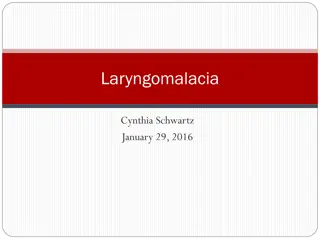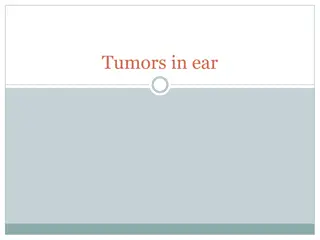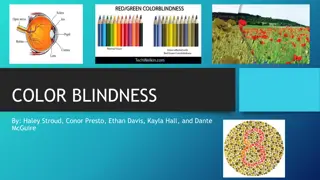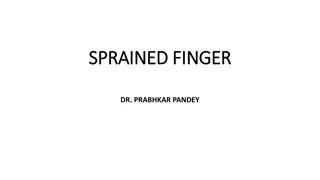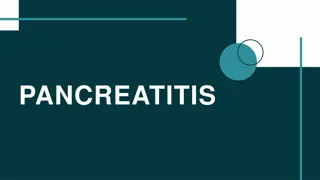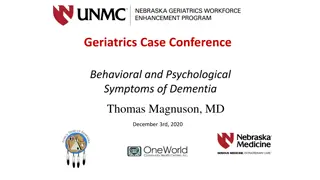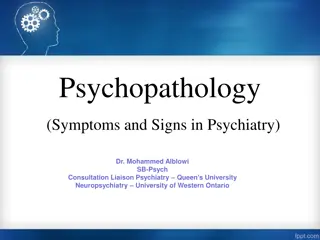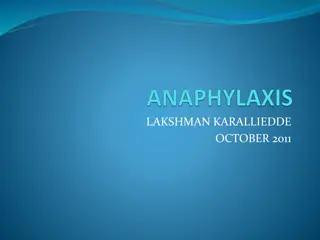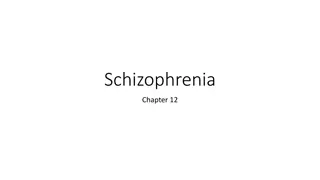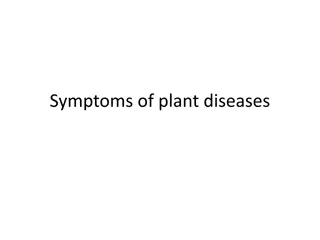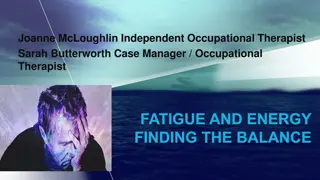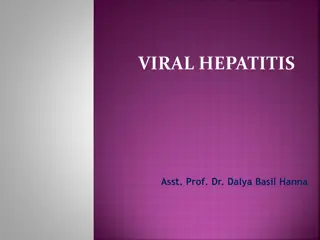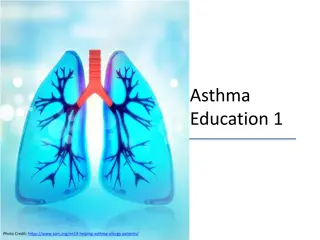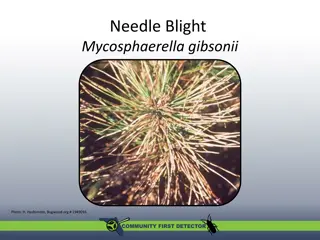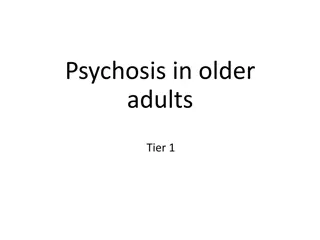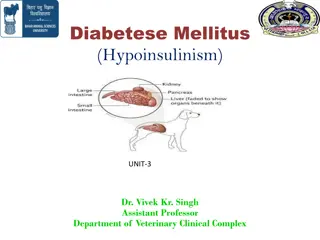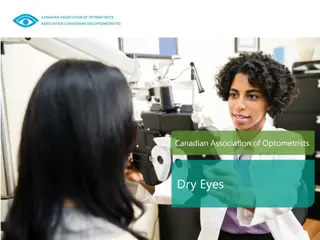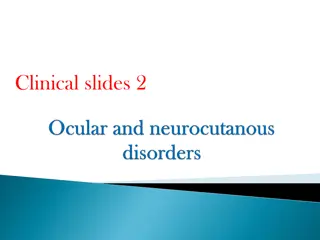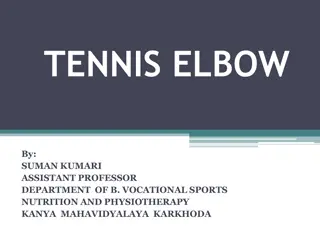Understanding Stridor: Causes, Symptoms, and Grades
Stridor is an abnormal high-pitched sound caused by disrupted airflow in the larynx or windpipe, often affecting children. It can indicate various underlying issues based on the type of stridor present. Grades of stridor range from mild to severe, with different treatment approaches for each. Infections and inflammations are common causes of acute stridor in children, with conditions like croup and bacterial tracheitis leading to respiratory distress. Prompt diagnosis and management are crucial for individuals experiencing stridor.
Download Presentation

Please find below an Image/Link to download the presentation.
The content on the website is provided AS IS for your information and personal use only. It may not be sold, licensed, or shared on other websites without obtaining consent from the author. Download presentation by click this link. If you encounter any issues during the download, it is possible that the publisher has removed the file from their server.
E N D
Presentation Transcript
stridor stridor
STRIDOR STRIDOR Stridor is an abnormal a high-pitched, wheezing (musical) sound or harsh sound caused by disrupted (turbilant) airflow. Airflow is usually disrupted by a blockage(partially obstructed) in the larynx (voice box) or trachea (windpipe). Stridor affects children more often than adults. It should not to be confused with stertor which is lower-pitched, noisy breath, snoring-type sound generated at the level of the nasopharynx, oropharynx, and, occasionally, supraglottis. .
Stridor is a symptom, not a diagnosis or a disease, and the underlying cause must be determined. THE three forms each suggest different causes, as follows: Inspiratory stridor suggests a laryngeal obstruction mainly supraglottis. Expiratory stridor implies tracheobronchial obstruction Biphasic stridor suggests a subglottic or glottic anomaly .
Pathophysiology Gases produce pressure equally in all directions; however, when a gas moves in a linear direction, it produces pressure in the forward vector and decreases the lateral pressure. When air passes through a narrowed flexible airway in a child, the lateral pressure that holds the airway open can drop precipitously (the Bernoulli principle) and cause the tube to close. This process obstructs airflow and produces stridor
Clinical grades of stridor Grade 1 (Exertional stridor) : Stridor appears during crying or exercise. Grade 2 (Continuous stridor or stridor at rest) : Stridor is present at rest & become worse with exertion. Infants < 1 yr of age should be hospitalized. Grade 3 (Stridor with retractions) : Stridor is continuous & accompanied with suprasternal& supraclavicular retractions The patient looks anxious, irritable, &struggling for breathing. Hospitalization is indicated for all cases. Grade 4 (Stridor with cyanosis) : In addition to continuous stridor & retractions, cyanosis& altered consciousness occur denoting severe respiratory failure. Urgent hospitalization & ET intubation , Or tracheostomy indicated.
Epidemiology (causes of STRIDOR) Acute stridor 1. INFECTION &INFLAMATION:- Laryngotracheobronchitis, croup, is the most common cause of acute stridor in children aged 6 months to 2 years. barking cough that is worse at night and may have low-grade fever. Bacterial tracheitis uncommon younger than 3 years. It is a secondary infection (most commonly due to Staphylococcus aureus) that follows a viral process . Retropharyngeal abscess is a complication of bacterial pharyngitis that is observed in children younger than 6 years. abrupt onset of high fevers, difficulty swallowing, refusal to feed, sore throat, hyperextension of the neck, and respiratory distress. .
Causes Acute stridor: Peritonsillar abscess between the superior constrictor muscles and the tonsil. . severe throat pain, trismus, difficult swallowing or speaking. Spasmodic croup, also termed acute spasmodic laryngitis, occurs most commonly in children aged 1-3 years. The presentation may be identical to that of croup. Epiglottitis is a medical emergency that occurs most commonly in children aged 2-7 years. Clinically, the patient experiences an abrupt onset of high-grade fever, sore throat, dysphagia, and drooling. potential space
Acute stridor: 2-Aspiration of foreign body age 1-2 years. A history of coughing and choking that precedes development of respiratory symptoms may be present 3-Allergic reaction (ie, anaphylaxis) occurs within 30 minutes of an adverse exposure. Hoarseness and inspiratory stridor may be accompanied by symptoms (eg, dysphagia, nasal congestion, itching eyes, sneezing, and wheezing) that indicate the involvement of other organs. 4-Trauma to airway like:- Blunt injury,,,Penetrating injury (knife, bullet,shelletc) neck,larynx. Burns ,inhalation of smokes, swallowing of hot drinks or corrosiv material,(oedema of airwaymucosa). Induced trauma by surgery or F.B removal endoscopy, bronchoscopy intubation of anesthesia. Trauma causing airway obstrction (stridor) due to Oedema ,Haemtoma, Bilateral vocal cord paralysis.
Chronic stridor Congenital cuases: Laryngomalacia is the most common cause of inspiratory stridor in the neonatal period and early infancy as 75% of all cases of stridor. Stridor may be exacerbated by crying or feeding. Placing the patient in a prone position with the head up alleviates the stridor; a supine position exacerbates the stridor. IT is usually benign , self-limiting and improves as the child reaches age 1 year. In cases where significant obstruction or lack of weight gain is present, surgical correction or supraglottoplasty may be considered if the clinician has observed tight mucosal bands holding the epiglottis close to the true vocal cords or redundant mucosa overlying the arytenoids. in older children (late-onset laryngomalacia) can differ from that of congenital laryngomalacia. Possible manifestations include obstructive sleep apnea syndrome, exercise-induced stridor, and even dysphagia. Supraglottoplasty can be an effective treatment option
Cong causes Vocal cord dysfunction: This is the next most common cause of infant stridor. The stridor is biphasic and associated with a weak cry. Unilateral vocal cord palsy is most common and can be secondary to birth trauma or intrathoracic surgery. It usually resolves in the first 2 years of life. Bilateral vocal cord paralysis is a more serious entity. ( aphonia and a high-pitched biphasic stridor that may progress to severe respiratory distress). It is due to CNS abnormalities, . Vocal cord paralysis in infants usually resolves within 24 months
Chronic stridor Subglottic stenosIS can present with inspiratory or biphasic stridor. Symptoms can be evident at any time during the first few years of life. If symptoms are not present in the neonatal period, this condition may be misdiagnosed as asthma. Congenital subglottic stenosis occurs when an incomplete canalization of the subglottis and cricoid rings causes a narrowing of the subglottic lumen. Acquired subglottic stenosis is most commonly caused by prolonged intubation.ORTrauma. (see also Glottic Stenosis).
Chronic stridor Laryngeal disorders: Congenital laryngeal webs can cause biphasic stridor. Laryngeal dyskinesia, exercise-induced laryngomalacia and other disorders produce stridor. Laryngeal tumours may cause stridor. These may be laryngeal cysts are a less frequent cause of stridor, haemangiomas (rare) present in the first 3-6 months of life and regress by age 12-18 months, or Respiratory papillomatosis. these conditions treated by oral steroidor intralesional steroid ,co2 or KTP laser. Tracheomalacia: This is caused either by external compression or, more commonly, by a defective tracheal cartilage It is the most common cause of expiratory stridor. Choanal atresia: Most common congenital anomaly of the nose in infants. Unilateral may be asymptomatic. Bilateral may present with apnoea or cyanosis during feeding.
Tracheal stenosis: of the proximal trachea can cause stridor. Tracheal stenosis can be congenital or secondary to extrinsic compression. Congenital stenosis is usually related to complete tracheal rings, is characterized by a persistent stridor and a prolonged expiratory phase , and necessitates surgery based on symptom severity. Other congenital causes of tracheal stenosis include external compression from aortic arch abnormalities
Acute stridor in adults Airway trauma: blunt,penetrating,burn can present with stridor and sudden onset of dysphonia and haemoptysis. . Anaphylaxis: As with children, this causes stridor with upper airway oedema and laryngospasm. There is often nasal congestion and profuse, watery rhinorrhoea. These respiratory effects are typically preceded by other symptoms including fear, weakness, increased sweating, sneezing, urticaria, erythema and angio-oedema. The signs of shock can then follow rapidly.
Stridor Adult Acute laryngitis: Stridor is caused by severe laryngeal oedema. It is usually accompanied by hoarseness. Aspiration of foreign body: Stridor is of sudden onset and is life-threatening. There may also be paroxysmal coughing, gagging or choking, hoarseness, wheezing, tachycardia and other signs of respiratory distress. Patients are usually anxious and distressed. Narrowing above the larynx causes stridor. Such narrowing may be caused by: Acute epiglottitis. Although rare in adults, it does occur. Retropharnygeal abscess, particularly in adolescents and young adults
Adult stridor Laryngospasm may cause stridor: In hypocalcaemia accompanied by paraesthesia, and other signs of calcium deficiency. Inhalation injury. This occurs after inhalation of smoke or toxic fumes. Laryngeal oedema and bronchospasm develop within 24 hours.
Chronic stridor in adults Laryngeal tumour: Stridor is a late sign accompanied by dysphagia, dysphonia and enlarged cervical lymph nodes. Laryngeal inflammation, causes include: Tuberculosis. Syphilis. Diphtheria. Sarcoidosis. Wegener's granulomatosis. Cricoarytenoid ankylosis in: Rheumatoid arthritis
Tumours causing compression: Mediastinal tumours: These can eventually compress the trachea and bronchi. Stridor is accompanied by hoarseness, brassy cough, tracheal shift or tug and distended neck veins. Retrosternal thyroid: Stridor with dysphagia, cough, hoarseness and tracheal deviation. Thoracic aortic aneurysm: Signs and symptoms are similar to mediastinal tumour. Iatrogenic causes include: Bronchoscopy or laryngoscopy. Prolonged intubation. and Neck surgery
DIAGNOSIS &MANAGEMENT OF STRIDOR DIAGNOSIS &MANAGEMENT OF STRIDOR A careful history gives helpful clues as to the aetiological cause of the stridor. Examination may occasionally help confirm the diagnosis. It is important to consider the age of the patients and whether the stridor is acute or chronic. Adults: oOnset, duration, progression and severity should all be assessed. oPast medical history and details of any trauma or surgery
History Children: Age of onset. Duration, progression and severity of stridor. Precipitating factors (feeding, crying). Whether positional (worse right/left, prone/supine). Whether aphonia is present. Other symptoms (cough, aspiration, drooling, choking, cyanosis, sleep). Severity (colour change, respiratory effort, apnoea). Perinatal history. Developmental history. Vaccination history. Growth and weight gain.
Examination Consider: Upper airway examination for any visible obstructive lesion Examination of cardiovascular system Signs of respiratory distress and cyanosis Examination of neck for local trauma and injury Suprasternal inspiratory in-drawing Patients suspected of having acute epiglottitis should not be examined. Observe: Drooling from the mouth. Character of cry, cough and voice. In children, the craniofacial features, nasal patency and any cutaneous haemangiomas. Any positional preference that alleviates stridor. Fever and signs of toxicity suggesting bacterial infection. oDeviation of the trachea.
Differential diagnosis according to age: In neonates, consider particularly congenital laryngeal paralysis or choanal atresia. In children, consider inhaled foreign bodies (such as toys or peanuts), croup, acute epiglottitis, diphtheria, upper airway burns and anaphylaxis. In adults, consider anaphalaxis, thyroid disease, trauma and tumours. Rarely, psychogenic stridor in young women.[ .
Investigations Mild stridor may require no investigation . The need dependon clinical situation, the degree of distress and the severity of the stridor. The following may be useful: Pulse oximetry. & Arterial blood gases. Imaging: AP and lateral X-rays of the neck and chest (can identify particularly epiglottitis). Special view X-rays (inspiratory/expiratory and lateral decubitus X-rays to demonstrate air trapping). Contrast studies (if compression, tracheo-oesophageal fistula, gastro-oesophageal reflux suspected). CT scanning (for aberrant vessels and mediastinal masses). MRI scanning (particularly for upper airway and vascular abnormalities). Bronchoscopy . Other tests and procedures: Pulmonary function tests (differentiating restrictive/obstructive lesions and upper/lower airway obstruction). Laryngoscopy and bronchoscopy (after oxygen saturations are stable and acute epiglottitis excluded
MANAGEMENT: Out patients management 1. Most afebrile patients with mild infectious laryngitis, mild laryngotracheobronchitis, or spasmodic laryngitis can be managed at home. 2. Warm & moist environment : by taking the child into a bathroom & turning on the hot shower or hot taps. . Inhalation of the hot steam will usually relieve minor obstruction within 30-60 minutes. 3. Drug therapy: Antibiotics (as amoxicillin) & steroids ( as dexmethasone) may be used especially in borderline moderate cases to need for hospitalization. Expectorants or mucolytics may be used in croup.
Hospital management 1. Hospitalization Is indicated : 1. Any infant with grade 2stridor 2. Any child with grade 3 stridor 3. Suspected bacterial disease (high fever& severe obstruction) 4. Grade 4 stridor is an indication of immediate hospitalization & ET- intubation. 2.Close observation : HR, RR, degree of retractions, colour, &level of consciousness is very essential to assess the course of the illness & to identify those in need for ET-intubation. 3.Minimal disturbances : Avoid disturbance or anxiety to child. The mother should remain beside the child for reassurance,
4.Humidification : Warm & moist atmosphere . Inhalation of warm water vapor helpful in relieving the laryngeal obstruction. by: 1. moistens secretions to facilitate clearance 2. Soothes inflamed mucosa & 3. provides comfort & reassurance to the child, & anxiety. 5.Drug therapy : include: 1. Nebulized epinephrine : constriction of the precapillary arterioles through the - adrenergic receptors fluid resorption from the interstitial space so in the laryngeal mucousa edema. . .
2. Corticosteroids : It is the most commonly used This edema in the Laryngeal Mucosa through their anti-inflammatory action. . A single IM dose of dexamethasone o.6 mg/kg (sometimes, a dose as low as 0.15 mg/kg may be effective). Oral dexamethasone is also effective. Oral prednisolone 1-2mg/kg may be used.
3. Antibiotics: not indicated in croup (viral) but parenteral antibiotic therapy is important when a bacterial infection is suspected especially in those with high fever. Oxygen therapy Feeding I.V fluid 1st24 hrs then oral feeding depending on severity of conditions or the cause
Fortunately, 98% of cases improve within 48 hrs with the previous measures. In 2% of cases, ET intubation (or tracheostomy) is necessary to relieve the severe obstruction. The main indications are (sign of respiratory distres):-like cyanosis, altered consciousness ,extreme restlessness, or gradual progression of the degree of the airway obstruction . Patients may be safely discharged home after 2-3 hrs period of observation provided there are no stridor at rest, normal air entry, normal color, normal level of consciousness, & given steroids.
Prognosis of stridor cases 1.The outcome of acute laryngotracheobronchitis, laryngitis, & spasmodic laryngitis is excellent. 2.Most deaths from croup are caused by laryngeal obstruction or due to complications of tracheostomy. 3.Untreated epiglottitis has a mortality rate of 6% in some series (bad prognosis), but of the diagnosis is made & appropriate treatment is initiated at a proper time better


